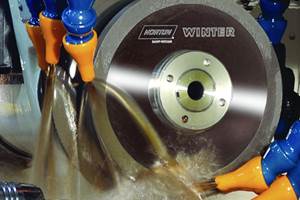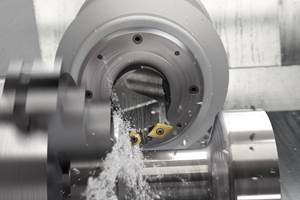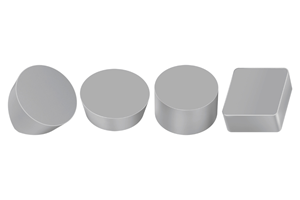Coating Improvements For Steel Turning
Relationships between coatings and substrate materials are keys to the performance of cemented carbide inserts.
A key premise of coating research today is the idea that the coating actually cuts the workpiece, not the insert body. Among various factors affecting performance and lifetimes of cutting tools, coatings are probably the most important. The coating's composition and adherence qualities are powerful promoters of metalworking productivity.
An important recent development applies to inserts for steel turning. New inserts can increase metal removal rates by 20 percent without sacrificing finish quality. They present a harder, more wear-resistant edge to the cutting zone, while supporting that edge with tough flanks that withstand heat and penetration by cracking.
To understand how coatings contribute to cutting-tool performance, let's examine all the factors involved in making inserts. Figure 1 presents an outline of substrate and coating characteristics and how the finished insert's geometry relates to its function. The substrate, coating and geometric form work together to enable a particular insert to meet its performance requirements.
Two Coating Methods
Physical vapor deposition (PVD) and chemical vapor deposition (CVD) are two processes used to apply coatings to inserts. PVD is a well-established technique primarily used for coating high-speed steel tools. To produce a sharp cutting edge, this process is commonly used with cemented carbide. The PVD process vaporizes the coating material and exposes the insert to this vapor at a temperature of approximately 900ºF. On the other hand, CVD coating is accomplished by chemical reactions between gases. For example, hydrogen, titanium chloride and methane react in a nitrogen atmosphere to create a TiCN coating.
In general, PVD coatings are thinner than coatings applied by CVD. The PVD process applies titanium nitride (TiN), titanium carbo-nitride (TiCN) and titanium aluminum nitride (TiAlN) coatings. CVD can apply TiN and TiCN, as well as other coatings, in layers up to 0.007-inch thickness. This process improves wear resistance, particularly with aluminum-oxide coatings. Multi-layer coatings of varying thickness may also be applied with CVD.
In CVD processes, inserts typically are heated to approximately 1,800ºF. Because this process is relatively easy to regulate, it permits controlled application of multiple layers. Orientation of each layer's crystalline structure may also be controlled during this process. Performance improvements have resulted from a controlled temperature-reduction process known as moderate-temperature chemical vapor deposition (MT-CVD). This process increases resistance to abrasion and plastic deformation.
Why Coat?
The main purpose of a tool coating is to improve productivity by allowing higher cutting speeds or feed rates. Although coatings sometimes extend tool lifetimes, this isn't usually their primary purpose. The principal rationale is to identify factors that might cause insert failure and to develop coating attributes that deal specifically with these factors.
Each aspect of a well-designed coating has a different function. The combinations of coating processes and coating materials may be regarded as recipes to protect inserts against failure. Figure 2 illustrates how different coatings affect insert performance and wear, with (-) indicating a negative effect, (+) a positive effect and (o) denoting no effect.
Other factors contributing to insert failure are not shown in Figure 2. For example, an insert's surface smoothness significantly affects chip formation when machining sticky materials. Chemical reactivity may also cause insert degradation at high temperatures.
Failure Analysis
Evaluating multi-layer coatings requires establishing a connection between coating failure and fracture of the insert body. In a typical scenario, if the outer coating slowly abrades and wears off, the tool surface loses its lubricity and generates excessive heat. In this case, if an inner coating cannot provide an adequate thermal barrier, heat penetrates the substrate and weakens it. In turn, overheated substrates may deform under cutting pressures. Such deformation frequently causes flaking of the coating and separation of the substrate from the coating, or separation between coating layers.
The coating, its component layers or the substrate may also crack when subjected to mechanical shock. To avoid this, they must be made from durable materials. If chemical bonding adheres the coating to its substrate, these bonds may fail at high temperatures due to accelerated chemical activity. For this reason, the bonds should be resistant to chemical attack.
New Steel-Turning Inserts
With these possibilities in mind, we can interpret the cross section of a coating used for Sandvik Coromant's (Fair Lawn, New Jersey) GC4000 grades of steel-turning inserts. In Figure 3, the thin, outer layer at the top is a multi-layer TiN coating applied by the CVD process. This shiny, gold material imparts lubricity to the surface and indicates wear as it slowly rubs off. With smearing metals, this lubricity provides resistance to built-up edge formation.
The next layer is fine-grained, columnar, alpha-phase aluminum oxide, a very hard material that provides a temperature barrier to protect the tool's inner body from excessive heat. This layer is applied via a high-temperature CVD process.
Beneath this is a layer of TiCN applied via a proprietary MT-CVD process to substantially improve the insert's performance. The columnar orientation and optimal grain size of this coating's crystals result from careful adjustment of process parameters during application. The crystals' end-wise orientation presents a harder surface where abrasive wear is concentrated. In addition, descending stress lines between crystals dissipate mechanical stress into the substrate material. If heat or mechanical shock creates micro-cracks that penetrate the surface layers, they will be dissipated downward along lines between the crystals. When this remaining force reaches the substrate, it is absorbed without propagating larger cracks. This gives the insert toughness and strength.
Engineered Substrate
Controlled variation of substrate materials also enhances coating performance. The substrate must be able to withstand stresses encountered in high-production, steel-turning operations. To address this need, a gradient sintering process varies the substrate's tungsten carbide/cobalt composition along the tool's periphery. This enriches the tool flank with cobalt for toughness to ensure better edge integrity during high-speed cutting. The nose area is enriched with tungsten carbide to impart hardness, resist wear and minimize plastic deformation.
This new family of steel-turning inserts permits speeds at least 20 percent higher than those possible previously, and many current applications exploit this advantage. The principal benefits appear in cases where the insert's greater resistance to plastic deformation permits dry machining and application of wiper-insert geometry. General applications include wet or dry roughing, semi-finishing and finishing.
Related Content
Norton | Saint Gobain Abrasives' Wheels Increase Metal Removal
The Norton Winter Paradigm Plus Diamond and Winter G-Force Plus Next Generation Diamond Wheels expand the company’s grinding wheel options.
Read MoreSandvik Coromant Turning Tools Enable Y-Axis Turning
The company has developed two new tools to support Y-axis turning: CoroTurn Prime and the CoroPlex YT twin-tool.
Read MoreWalter Ceramic Inserts Enable Efficient Turning, Milling
Suitable turning and milling applications of the WIS30 ceramic grade include roughing, semi-finishing and finishing, as well as interrupted cuts.
Read MoreTungaloy Adds Chipbreaker to Line of PVD-Coated Inserts
The PVD-coated insert grade series AH8000 performs in turning operations for heat resistant superalloys.
Read MoreRead Next
3 Mistakes That Cause CNC Programs to Fail
Despite enhancements to manufacturing technology, there are still issues today that can cause programs to fail. These failures can cause lost time, scrapped parts, damaged machines and even injured operators.
Read MoreObscure CNC Features That Can Help (or Hurt) You
You cannot begin to take advantage of an available feature if you do not know it exists. Conversely, you will not know how to avoid CNC features that may be detrimental to your process.
Read MoreThe Cut Scene: The Finer Details of Large-Format Machining
Small details and features can have an outsized impact on large parts, such as Barbco’s collapsible utility drill head.
Read More



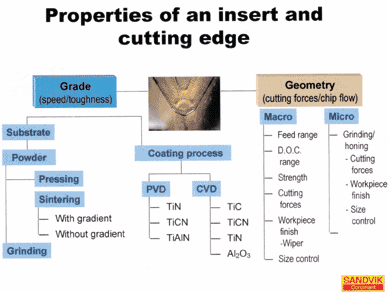
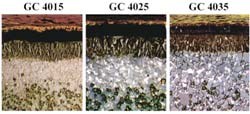




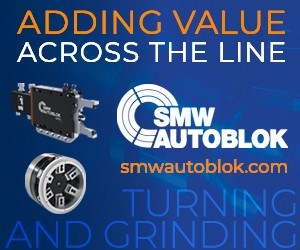





.png;maxWidth=300;quality=90)







.png;maxWidth=300;quality=90)

